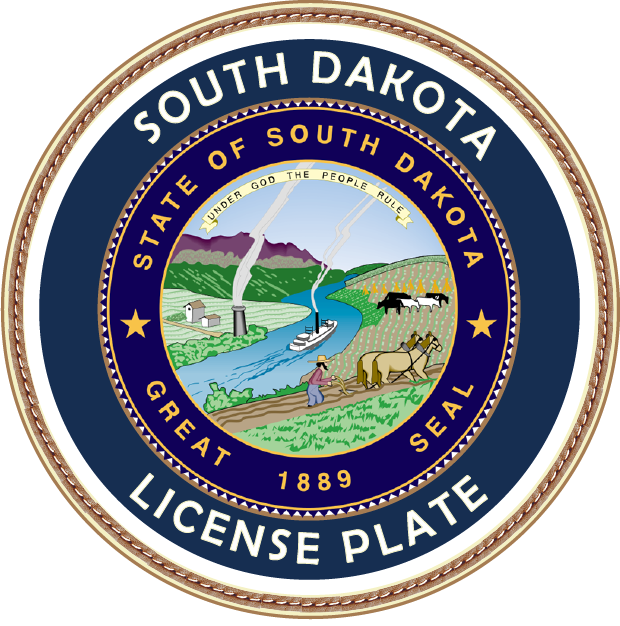About South Dakota License Plate
License plates are more than just metal rectangles on your vehicle — they serve as official identification and help law enforcement, parking attendants, and other drivers recognize vehicles on the road. In South Dakota, understanding how license plates work can save you time, money, and potential legal trouble.
This guide covers everything you need to know about South Dakota license plates, from registration and renewal to specialty plate options and state laws.
What Are License Plates?
License plates are state-issued metal tags with unique letter and number combinations that identify each vehicle. In South Dakota, only a rear license plate is required, simplifying compliance for drivers. The state’s iconic design features Mount Rushmore, symbolizing South Dakota’s heritage and pride.
Getting Your First South Dakota License Plate
If you’re moving to South Dakota, you have 90 days to register your vehicle and obtain plates. Visit your county treasurer’s office with your out-of-state title, proof of insurance, and a valid driver’s license. Complete the title and registration application, and your plates will be issued once payment is processed.
New vehicle owners must register within 45 days of purchase. Dealerships usually handle registration for you, while private buyers must bring all documentation (title, bill of sale, proof of insurance, and payment) directly to the treasurer’s office.
Registration Fees
South Dakota calculates registration fees based on vehicle age, weight, and value. Newer vehicles generally cost more to register, while fees decrease as vehicles age. Specialty or personalized plates may include extra costs to fund specific programs or cover custom manufacturing.
Renewing Your License Plate
South Dakota license plates expire on your birthday each year. You’ll receive a renewal notice about one month before expiration, with details on fees and renewal options. Renew early — you can renew up to 90 days in advance.
Renewal Options:
- Online: Fastest option via the South Dakota Motor Vehicle website.
- Mail: Send payment and renewal notice to your county treasurer’s office.
- In-person: Visit your treasurer’s office for questions or registration updates.
Late renewals incur a 10% penalty and may result in tickets or fines if caught driving with an expired plate.
Types of South Dakota License Plates
Standard Plates
The standard South Dakota plate displays Mount Rushmore with blue letters on a white background. It’s issued by default with your vehicle registration.
Specialty Plates
Specialty plates support causes and organizations such as veterans’ services, universities, and wildlife conservation. These plates cost an additional $25–$100 per year, part of which funds the associated program.
Personalized Plates
Personalized plates let you create a unique combination of up to seven characters. Applications are reviewed for appropriateness. There’s a $50 initial fee plus $25 annually.
Disability Plates
Drivers with permanent disabilities may apply for disability plates or placards with medical certification. These offer parking privileges at designated spaces and cost the same as standard registration.
License Plate Laws and Display Rules
South Dakota law requires plates to be clearly visible and securely attached to the rear of the vehicle. Avoid covers or frames that obscure numbers, letters, or the state name. Obstructed or unreadable plates can lead to citations.
Driving with expired or mismatched plates is illegal. Using fraudulent or stolen plates can result in criminal charges, heavy fines, or imprisonment.
Transferring or Returning Plates
When selling your vehicle, you may transfer your plate to a new vehicle by visiting your county treasurer’s office. Bring your current registration and new title. If you’re not purchasing another vehicle, return your old plates to officially cancel your registration.
License Plate History
South Dakota began issuing plates in 1905, among the earliest in the nation. Early plates were made of leather and metal, displaying simple number combinations. The Mount Rushmore designappeared in the 1950s and became a lasting symbol of the state.
Color schemes have changed over time — from blue and gold to white and red — reflecting each era’s design trends. Specialty plates introduced in the 1990s added diversity and personalization options.
License Plate Lookup and Privacy
Vehicle information tied to license plates is regulated under the Driver’s Privacy Protection Act (DPPA). While certain businesses and law enforcement can access plate records, individuals must have a valid reason. Misusing vehicle data for harassment or personal gain is illegal and punishable under state and federal law.
Keeping your registration current, displaying plates properly, and following state laws ensures a smooth driving experience in South Dakota. For personalized assistance or questions, contact your county treasurer’s office for up-to-date information.
